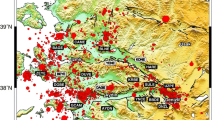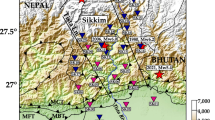Abstract
Variations of seismic background noise in South Korea have been investigated using power spectral analysis. We have estimated the power spectral density of seismic noise for 30 broadband stations from 2005 to 2007. In the frequency range 1–5 Hz, diurnal variations of noise level and daily differences in daytime noise level are observed at most stations, suggesting that cultural activities contribute to the noise level of a station. The variation in the number of stations detecting an event, however, suggests that cultural noise has little influence on the detection capability of events over magnitude 2.0. In the frequency range 0.1–0.5 Hz, a double-frequency (DF) peak is dominant at all stations. Clear seasonal variations of peaks are observed, while much less shown in the frequency range 1–5 Hz. DF noise levels are higher in winter than in summer. Strong DF peaks occur in summer when Pacific typhoons near the Korean Peninsula. The discrepancy in time between DF peaks at seismic stations and peaks of significant wave height at buoys, as well as the decrease of DF peaks with increased latitude, indicate that the likely source region of DF peaks is located in the Southern Sea of Korea.
Similar content being viewed by others
References
Aster, R. C. and Shearer, P. M., 1991, High-frequency borehole seismograms recorded in the San Jacinto fault zone, southern California. part 2. attenuation and site effects. Bulletin of the Seismological Society of America, 81, 1081–1100.
Barstow, N., Sutton, G. H. and Carter, J. A., 1989, Particle motion and pressure relationships of ocean bottom noise: 3900 m depth; 0.003 to 5 Hz. Geophysical Research Letters, 16, 1185–1188.
Bromirski, P. D., Duennebier, F. K. and Stephen, R. A., 2005, Midocean microseisms. Geochemistry Geophysics Geosystems, 6, Q04009, doi:10.1029/2004GC000768.
Carter, J. A., Barstow, N., Pomeroy, P. W., Chael, E. P. and Leahy, P. J., 1991, High frequency seismic noise as a function of depth. Bulletin of the Seismological Society of America, 81, 1101–1114.
Chevrot, S., Sylvander, M., Benahmed, S., Ponsolles, C., Lefevre, J. M. and Paradis, D., 2007, Source locations of secondary microseisms in Western Europe: Evidence for both coastal and pelagic source. Journal of Geophysical Research, 112, B11301, doi:10.1029/2007JB005059.
Friedrich, A., Kruger, F. and Klinge, K., 1998, Ocean-generated microseismic noise located with the Grafenberg array. Journal of Seismology, 2, 47–64.
Gordeev, E. I., 1990, Generation of microseisms in the coastal area. Physics of the Earth and Planetary Interiors, 63, 201–208.
Hasselmann, K., 1963, A statistical analysis of the generation of microseisms. Review of Geophysics, 1, 177–209.
Haubrich, R. A. and McCamy, K., 1969, Microseisms: Coastal and pelagic sources. Review of Geophysics, 7, 539–571.
Kedar, S., Longuet-Higgins, M., Webb, F., Graham, N., Clayton, R. and Jones, C., 2008, The origin of deep ocean microseisms in the North Atlantic Ocean. Proceedings of the Royal Society A, 464, 777–793.
Longuet-Higgins, M. S., 1950, A theory of the origin of microseisms. Philosophical Transactions of the Royal Society London, Series A, 243, 1–35.
Marzorati, S. and Bindi, D., 2006, Ambient noise levels in north central Italy. Geochemistry Geophysics Geosystems, 7, Q09010, doi: 10.1029/2006GC001256.
McNamara, D. E. and Buland, R. P., 2004, Ambient noise levels in the continental United States. Bulletin of the Seismological Society of America, 94, 1517–1527.
Peterson, J., 1993, Observations and modeling of background seismic noise. U.S. Geological Survey, Open-File Report, 93-322, pages 1–95.
Rhie, J. and Romanowicz, B., 2004, Excitation of Earth’s continuous free oscillations by atmosphere-ocean-seafloor coupling. Nature, 431, 552–556.
Rind, D. and Donn, W. L., 1979, Microseisms at Palisades, 2. Rayleigh wave and Love wave characteristics and the geologic control of propagation. Journal of Geophysical Research, 84, 5632–5642.
Ringdal, F. and Bungum, H., 1977, Noise level variation at NORSAR and its effect on detectability. Bulletin of the Seismological Society of America, 67, 479–492.
Schulte-Pelkum, V., Earle, P. S. and Vernon, F. L., 2004, Strong directivity of ocean-generated seismic noise. Geochemistry Geophysics Geosystems, 5, Q03004, doi:10.1029/2003GC000520.
Withers, M. M., Aster, R. C., Young, C. J. and Chael, E. P., 1996, High-frequency analysis of seismic background noise as a function of wind speed and shallow depth. Bulletin of the Seismological Society of America, 86, 1507–1515.
Young, C. J., Chael, E. P., Withers, M. M. and Aster, R. C., 1996, A comparison of the high-frequency (>1 hz) surface and subsurface noise environment at three sites in the United States. Bulletin of the Seismological Society of America, 86, 1516–1528.
Author information
Authors and Affiliations
Corresponding author
Rights and permissions
About this article
Cite this article
Sheen, DH., Shin, J.S. & Kang, TS. Seismic noise level variation in South Korea. Geosci J 13, 183–190 (2009). https://doi.org/10.1007/s12303-009-0018-0
Received:
Accepted:
Published:
Issue Date:
DOI: https://doi.org/10.1007/s12303-009-0018-0




